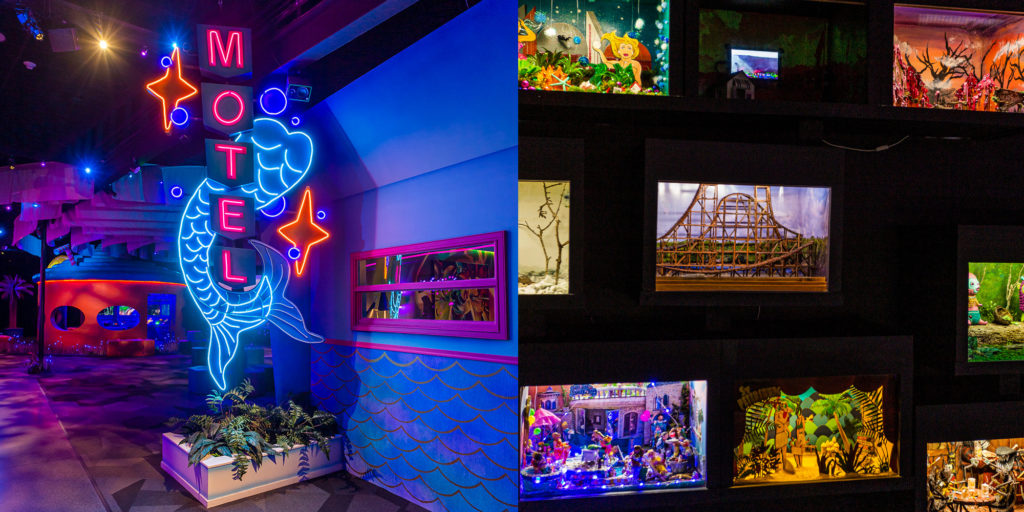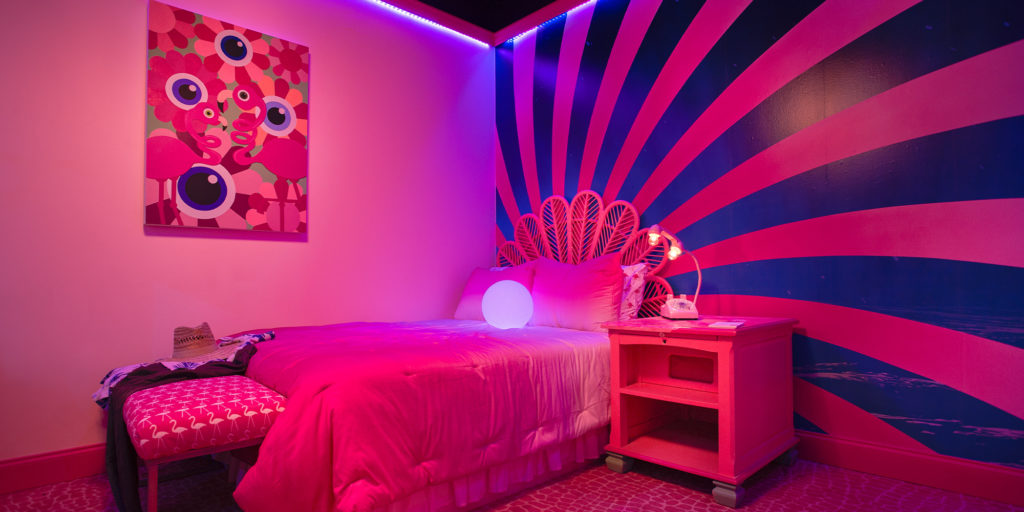The first step to visiting Fairgrounds St. Pete is to forget everything you know about what it means to experience art. (Well, maybe that’s step two. Fairgrounds uses a timed entry system, so you might want to buy your ticket first. Then proceed with step one.)
Then, prepare yourself to leave behind weird, wacky, wonderful Florida and step into… weird, wacky, wonderful Florida, as envisioned by 60-plus local artists in vivid, neon-bright mediums ranging from sculpture and light design to dioramas. The fully immersive art experience takes the idea of a museum and flips it on its head. You’re meant to engage with the art by doing more than just looking at it; when you enter, you become part of the story.
“We like to say it’s a story-full experience or a choose your own adventure,” says Liz Dimmitt, the CEO and co-founder of Fairgrounds St. Pete, which is scheduled to open in late summer. “There is a loose narrative framework that you could investigate and spend time learning the story or exploring some mysteries. You can sort of dive into the story as deeply as you want to… and different people on our team have different interpretations of the story. Nothing is really confirmed, but there are some sort of mysteries to be solved or things to figure out and clues and information throughout the space to help you put that together.

“That narrative framework, we worked on [it] as a team, and it was a great tool for us to share with artists — weird, wacky, wonderful Florida,” she adds. “That theme and some sort of loose narrative ideas around that was a great way for them to have their work fit in or be compatible with what was going on within the space.”
Dimmitt, a Pinellas County native, spent nearly two decades in the New York City art world, all while keeping a close connection to her hometown’s art scene. She eventually partnered with Jeff and Penny Vinik (the main investors behind Fairgrounds St. Pete, their first placemaking investment across the bridge) on installations like BEACH Tampa and Yayoi Kusama’s Love is Calling Infinity Room at the Tampa Museum of Art.
When the time came to launch her own project, she was introduced to Mikhail Mansion, a local artist who combines his background in computer programming with his passion for art to create the tech-focused philosophy that the two would soon apply to Fairgrounds. Alongside Mansion’s wife, Olivia, the three ventured forth in early 2020 to fill 16,000 square feet of warehouse space with art, technology and entrepreneurship.
It’s at this intersection that Fairgrounds exists, Olivia Mansion says.
“We really view entrepreneurship as a medium, just like an artist could view paint as a medium or a technologist could use their computer and software as a medium,” she explains. “Entrepreneurship is very creative, and we view artists as entrepreneurs. Even if they don’t realize it themselves, they have a business, and they have to learn how to market themselves and price and pay taxes and like all of these things. Entrepreneurship is really the future, [with so many people] having some sort of side hustle, where they’re generating and providing value to the community and to the economy. That’s really what Fairgrounds is providing — a resource not only to artists, through artists opportunities, and through our unique profit sharing model, but it’s also providing a service through these immersive experiences for the local and international community.”

“The idea is really to invest in our local community and hope that artists can take that money and invest it in their own practice,” she says. “Hopefully, we’re putting money out there to artists, and they make the next great thing and we get to show that at Fairgrounds. They can invest in new materials or push their practice somewhere new or explore some new ideas.”
After all, new ideas are what Fairgrounds is all about. Mikhail Mansion, the project’s chief technology officer, developed an infrastructure of roughly 100 computers to facilitate whatever kinds of interactions between art and technology (from projections to moving televisions and interactive lighting) the artists can dream up. They were already pushing the boundaries of this marriage between art and tech before COVID-19. Once the pandemic hit, their plans for highly touchable, interactive displays were tossed out, and new tech was developed to keep the engagement but minimize the contact for guests.
“The touchless button was the very first thing that we started making, which we’ve incorporated in a bunch of places. Essentially that’s just a way to “press” something [by making a gesture] and have an interaction or activate something but not physically make contact with any material,” Mansion says. “That was [done through] custom electronics, sensors, lighting feedback and sound feedback. We also made our own foot pedals, so people could step on them and things can happen that way. Also, gesture-controlled cameras as well as a sensor input… Those were all innovations that were coming from wanting people to be able to interact with the immersive exhibits but in a safe way.”
Artists had few limits on their creativity as long as their work stuck within the loose ode to Florida. The centerpiece of Fairgrounds is the Mermaid Star Motel, complete with an old-school illuminated road sign. While you’re there, keep an eye on the TVs, pick up the phone, and don’t forget to grab yourself a brochure.
“All those brochures have been created [by the artists],” Dimmitt says. “They’re really funny, and there’s great wordplay, but it’s just a great example of how everything you see is part of the experience. I just love the little details and how everything fits together.”
It’s these quirky little hidden gems that the Fairgrounds team will help connect with art lovers and the art hesitant alike.
“You don’t have to think about Fairgrounds as a destination for art or artwork,” Dimmitt says. “You could just think about it as a really fun experience. But maybe it helps expand that definition of art or democratizes it [to] meet a larger audience.”
It’s also another reminder for tourists and locals alike why we love the usually bizarre, never boring Sunshine State.
“It really is sort of a love letter to our artists and to Florida,” Dimmitt adds.



